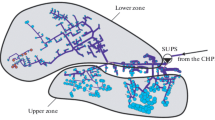Conclusions
-
1.
The improvement of the ACSTP of a hydroelectric plant is an ongoing complex program of economic, technical, and organizational measures that are related on an organizational basis to improvement of the operational organization of a hydroelectric plant or network of hydroelectric plants, both active and under design. These measures are still more effective with the simultaneous improvement of control systems of higher-standing levels.
-
2.
Domestic and foreign experience with the improvement of automatic control systems for active hydroelectric plants indicates that the greatest savings due to these measures is realized where the hydroelectric power plants are united organizationally into networks of plants.
-
3.
To create objective conditions for increasing the efficiency of control systems, it is expedient to build complex production subdivisions responsible for the development, design, implementation, and operation of control systems in design organizations, at the hydroelectric power plants, and regional power administrations (PÉO).
-
4.
One of the fundamental deficiencies encountered in planning plant organization and control, which supports the introduction of highly efficient automatic control systems, is the absence in the plans of alternate schemes for the organization of the operation of networks of hydroelectric plants, and also promising organizational structural linked with the system being designed for control of a hydroelectric plant (network of plants).
-
5.
In revising the GOSTs for a ACSTP, it is necessary to eliminate existing inaccuracies that create the potential for their contradictory interpretation, e.g., in determining automated systems for the control of projects as a function of the presence of electronic computers in their makeup.
-
6.
The solution of new problems in the ACSTP of a hydroelectric plant (unit optimization, technical equipment diagnostics, adjustment of unit assignments in accordance with active capacity, analysis of the efficiency of utilization of the water passing through the hydroelectric plant, etc.) is restrained, on the one hand, by the impromptu character of the methods employed for solution of these problems, and on the other, by the absence of a standard base for water usage, and apparatus for regulating the parameters and conditions required by the specifics of the project, by the incompleteness of the individual technological systems, and by the inadequate reliability of certain control facilities, including the electronic computer. This will also impede the widespread introduction of microcomputers in control systems.
-
7.
The introduction of new effective centralized-control facilities (new systems) requires the mobile rebuilding of the organizational structures of the traditional facilities put together under operating conditons, and specialization.
Similar content being viewed by others
Additional information
In publishing the paper by K. E. Baskin and Yu. A. Stasenkov, the editorial staff proposes to open discussion on the circle of problems that we have touched upon and invites the readership to take part in their discussion in the pages of the journal.
Translated from Gidrotekhnicheskoe Stroitel'stvo, No. 3, pp. 35–39, March, 1980.
Rights and permissions
About this article
Cite this article
Baskin, K.E., Stasenkov, Y.A. Improving control systems for hydroelectric plants. Hydrotechnical Construction 14, 270–277 (1980). https://doi.org/10.1007/BF02305130
Issue Date:
DOI: https://doi.org/10.1007/BF02305130



